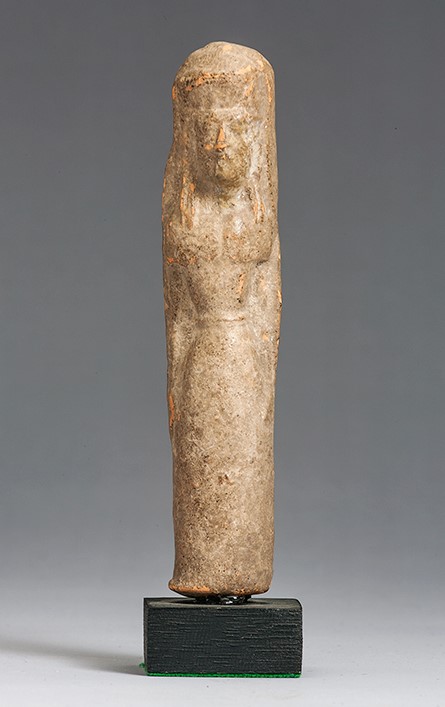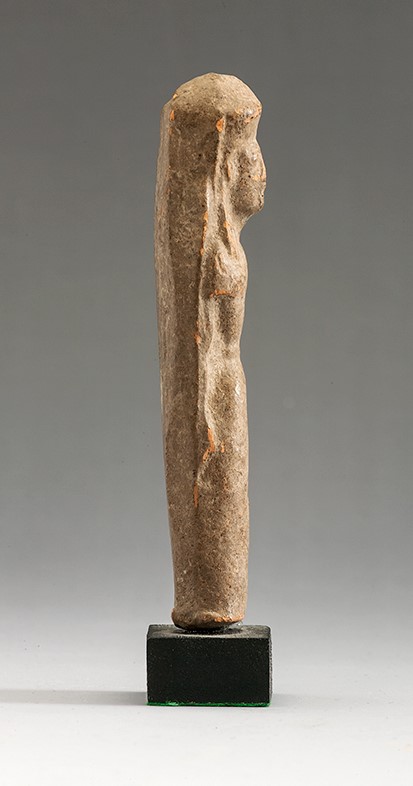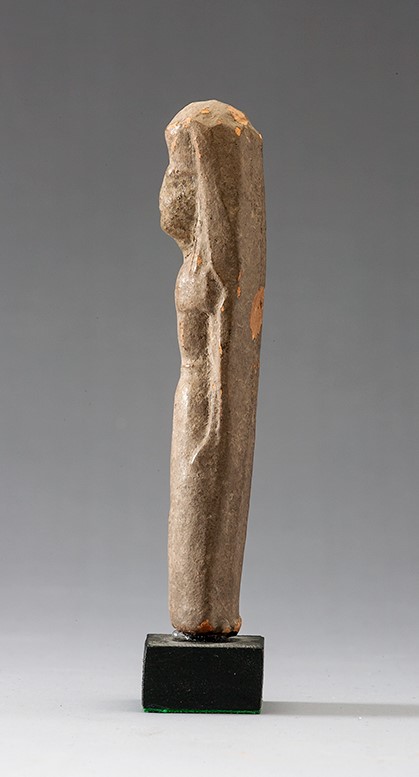Acquisition number: 1983.02
Intact but for some minor chips from the surface at the rear. Orange-buff clay with a few very small dark inclusions, fine and well finished. The surface is covered with a slip which now appears grey. There are no traces of paint. The figurine will not stand and is at present mounted on a wooden base.
The figure is cast solid and has a roughly cylindrical form. The back is not modelled and shows evidence of vertical paring. The front was impressed in a somewhat worn mould. The figure has a polos on her head and wears a shawl (epiblema) about her shoulders over a long, belted peplos which comes down to cover the feet. The features of the face are prominent and she has large hands reaching fairly low on the thighs. The hair is long and comes down onto the front of the shoulders.
No traces of paint are preserved.
Title: Standing Goddess - 1983.02
Acquisition number: 1983.02
Author or editor: J.R. Green
Culture or period: Greek Archaic.
Date: c. 600 BC.
Material: Clay - Terracotta
Object type: Sculpture and figurines
Dimensions: 22mm (w) × 101mm (h)
Origin region or location: Italy
Origin city: Sicily.
Display case or on loan: 3
Keywords: Greek, Archaic, Sicily, Figurine, Daedalic
Charles Ede Ltd (London), Antiquities 126 (1983) no. 1.
1983.02
Standing Goddess
Purchased. Ht. 10.1cm; max. width 2.2.cm.
Intact but for some minor chips from the surface at the rear. Orange-buff clay with a few very small dark inclusions, fine and well finished. The surface is covered with a slip which now appears grey. There are no traces of paint. The figurine will not stand and is at present mounted on a wooden base.
The figure is cast solid and has a roughly cylindrical form. The back is not modelled and shows evidence of vertical paring. The front was impressed in a somewhat worn mould. The figure has a polos on her head and wears a shawl (epiblema) about her shoulders over a long, belted peplos which comes down to cover the feet. The features of the face are prominent and she has large hands reaching fairly low on the thighs. The hair is long and comes down onto the front of the shoulders.
No traces of paint are preserved.
The figurine is a good example of the later phase of the so-called Daedalic style. In general terms it recalls the Auxerre statuette in the Louvre (e.g. Lullies and Hirmer, Greek Sculpture pl. 6, A. Stewart, Greek Sculpture. An Exploration [New Haven - London 1990] pll. 27-28), both in the shape of the head, the large hands and the simple drapery.
The polos on the head indicates that the figure is either a goddess or a votary. For parallels, see R.A. Higgins, Greek Terracottas (London 1967) 25-28, pl. 100. G. Olbrich, “Sybaritica”, Parola del Passato 264, 1992, 183-224 includes a good discussion (with parallels) of a series of seven not dissimilar pieces from Magna Graecia and datable to the last quarter of the seventh century. For a fuller coverage, including related types, G. Olbrich, Archaische Statuetten eines metapontiner Heiligtums (Rome 1979); M. Albertocchi, “Daedalica selinuntina II. Osservazioni sulla coroplastica selinuntina d'età tardo-orientalizzante”, in: C. Antonetti and S. De Vido (eds), Temi selinuntini (Pisa 2009) 9-27.
Sicily; ca 600 BC.
Charles Ede Ltd (London), Antiquities 126 (1983) no. 1.


